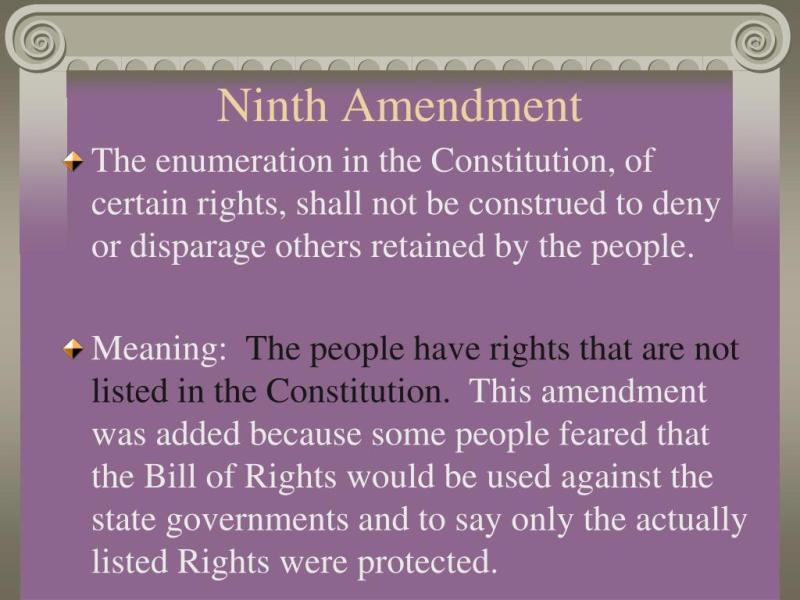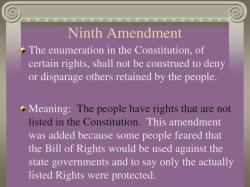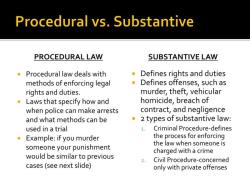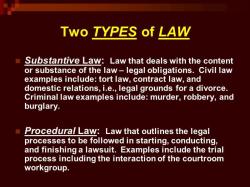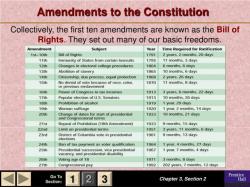What is the common purpose of the ninth and Tenth Amendments?
The Ninth and Tenth Amendments to the United States Constitution both address the relationship between the federal government and individual rights, emphasizing limitations on governmental power. While they serve distinct roles, their common purpose lies in preserving the rights and liberties of individuals and preventing the federal government from overreaching its authority.
Ninth Amendment:
- Text: "The enumeration in the Constitution, of certain rights, shall not be construed to deny or disparage others retained by the people."
- Purpose: The Ninth Amendment emphasizes that the listing of specific rights in the Constitution should not be interpreted as an exhaustive list. It recognizes the existence of unenumerated rights, meaning that individuals possess rights not explicitly mentioned in the Constitution. This amendment underscores the broader concept that people have rights beyond those explicitly stated in the document.
Tenth Amendment:
- Text: "The powers not delegated to the United States by the Constitution, nor prohibited by it to the States, are reserved to the States respectively, or to the people."
- Purpose: The Tenth Amendment reinforces the principle of federalism by stating that powers not specifically granted to the federal government by the Constitution, nor prohibited to the states, are reserved for the states or the people. It limits the scope of federal authority and emphasizes the autonomy of state governments in areas not explicitly addressed by the Constitution.
Common Purpose:
- Both amendments work together to establish a framework of limited government. The Ninth Amendment ensures that individuals retain rights beyond those explicitly listed, emphasizing a broad interpretation of rights. The Tenth Amendment reinforces this by affirming that powers not granted to the federal government are reserved for the states or the people, promoting a decentralized system of governance.
In summary, the common purpose of the Ninth and Tenth Amendments is to protect individual rights and limit federal government powers, recognizing that citizens have rights beyond those explicitly mentioned and that state governments have reserved powers in the absence of federal authority.
Exploring the shared objectives of the Ninth and Tenth Amendments
The Ninth and Tenth Amendments, while seemingly distinct in their wording, share some interesting and important objectives. Let's explore how these often overlooked amendments work together:
Shared Objective: Limiting Federal Power:
- Ninth Amendment: Protects unenumerated rights retained by the people, preventing the federal government from claiming those rights don't exist simply because they aren't explicitly listed in the Constitution. This acts as a negative check on federal power.
- Tenth Amendment: Reserves all powers not delegated to the federal government to the states or the people. This explicitly limits the federal government's scope, preventing it from overreaching into areas not intended for its control. Both amendments, in their own ways, aim to restrict the federal government's power and maintain a more decentralized system of governance.
Shared Objective: Protecting Individual Liberty:
- Ninth Amendment: Recognizes that people have inherent rights beyond those listed in the Constitution, providing a basis for future recognition and protection of evolving individual liberties.
- Tenth Amendment: Empowers states and individuals to determine matters not delegated to the federal government, potentially allowing for greater variation in regulations and policies that may better reflect local needs and values. Both amendments, in their own ways, contribute to the protection of individual liberty by limiting the reach of the federal government and allowing for greater local autonomy.
Shared Objective: Promoting Federalism:
- Ninth Amendment: By acknowledging unenumerated rights, it allows for continued evolution and adaptation of the Constitution, promoting a dynamic federalism responsive to changing societal needs.
- Tenth Amendment: By reserving unenumerated powers to the states, it strengthens the role of state governments and fosters a cooperative federalism where both federal and state governments have their distinct spheres of influence. Both amendments, in their own ways, contribute to a healthy federalism where power is shared and distributed, preventing excessive centralization.
It's important to note that these shared objectives are not without tension. The Ninth and Tenth Amendments have been used in various legal arguments, sometimes with conflicting interpretations. For example, the Ninth Amendment has been used to argue for abortion rights, while the Tenth Amendment has been used to defend laws restricting abortion.
Ultimately, understanding the shared objectives of the Ninth and Tenth Amendments provides valuable insight into the ongoing debate about the balance of power between the federal government and the states, as well as the ongoing pursuit of individual liberty and a responsive federalism.
